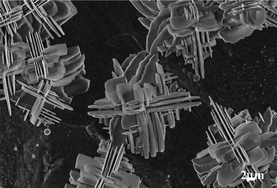Morphology evolution of lead-free ceramics: formation of Bi0.5Na0.5TiO3 superstructures on a Ti substrate
Abstract
Bi0.5Na0.5TiO3 (BNT) piezoelectric superstructures were successfully synthesized by hydrothermal methods and characterized by

* Corresponding authors
a
Department of Physical Chemistry, University of Science and Technology Beijing, Beijing, PR China
E-mail:
zhangmei@ustb.edu.cn
Tel: +86-10-62334926
Bi0.5Na0.5TiO3 (BNT) piezoelectric superstructures were successfully synthesized by hydrothermal methods and characterized by

 Please wait while we load your content...
Something went wrong. Try again?
Please wait while we load your content...
Something went wrong. Try again?
J. Yu, M. Zhang and M. Guo, CrystEngComm, 2011, 13, 1953 DOI: 10.1039/C0CE00287A
To request permission to reproduce material from this article, please go to the Copyright Clearance Center request page.
If you are an author contributing to an RSC publication, you do not need to request permission provided correct acknowledgement is given.
If you are the author of this article, you do not need to request permission to reproduce figures and diagrams provided correct acknowledgement is given. If you want to reproduce the whole article in a third-party publication (excluding your thesis/dissertation for which permission is not required) please go to the Copyright Clearance Center request page.
Read more about how to correctly acknowledge RSC content.
 Fetching data from CrossRef.
Fetching data from CrossRef.
This may take some time to load.
Loading related content
